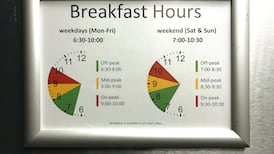My regular 2km circuit takes me into my local park, along the river and back through town, past the displays of mannequins still dressed in spring colours and the signs tacked to shop windows. Each one is a postcard from the recent and yet unimaginably distant past, a missive of fear, uncertainty and heartbreaking optimism. “Waiting on News to Re-open.” “Remember to Love One Another. See You All Soon.” “Back in 5 Mins.”
The signs are scrawled reminders that we can’t go on like this forever. But the idea that we might not go on like this is, in some ways, just as frightening.
A degree of doubt is creeping into updates from public health experts in recent days about whether restrictions will begin to be lifted on May 5th. At some point soon though, we’ll have no choice but to ease ourselves back into life, into some form of accommodation with the virus. The alternative – to hide away, as I heard some people swear they would do last week, until “it’s 100 per cent safe” – is just as implausible as suggesting we throw open the doors and party in the street. A vaccine or a therapeutic treatment could be 18 months away. It could be seven years away. We might never get a vaccine.
As the experts are discovering, locking down was the easy bit. The unlocking will be much more difficult or, as the leaked Government memo this week put it, "far more divisive". It will be divisive because of the reasons it baldly outlined: we are mired in unemployment, debt, restrictions and grief. And it will be divisive because the idea that has kept us going – the notion that has preserved our sanity and our solidarity – is that we're all in this together.
But that is about to be challenged. Society can’t reopen all at once. The question now is which sector, demographic group, or region goes first. This is when solidarity begins to fray.
One way to reopen might be to follow a regional model like Italy, and ease restrictions in the counties with the lowest number of cases first. But if you thought the prospect of middle class second homeowners from Dublin descending on their holiday pads in Connemara or Dunmore East over Easter was contentious, imagine the chaos that would ensue if Galway or Waterford began to open up, while Dublin remained in full lockdown. The idea, as one observer pointed out last week, that we might end up a hard border on the island after all, except now it's between two neighbouring counties, isn't a runner.
There is another alternative. Could New Zealand’s bubble strategy offer us a way out of lockdown?
The country of five million people, which has had just over a thousand cases and fewer than 20 deaths, plans to move out of its most severe level four lockdown from next week, into level three. During level four, businesses were shut and everyone stayed at home within their household “bubbles”, rules that were enforced with threats of fines and jail, but mostly relied on civic responsibility. If your neighbour threw a ball into your garden, you weren’t allowed to throw it back.
Some businesses and schools will reopen next week, though students are urged to continue remote learning if they can. And the bubbles can be expanded slightly “to reconnect with close family or bring in caregivers, or support isolated people.” If a relative or loved one is alone “you can extend your bubble to include them”.
New Zealand is in a very different place to Ireland, but a version of its bubbles concept could work here. It would offer the 400,000 people who live alone, without family close by, the chance to create a bubble with a friend or neighbour. In later phases, two families could decided to merge their bubbles, sharing the burdens of homeschooling and childcare. The Guardian reported that Stefan Flasche, an epidemiologist at the London School of Hygiene and Tropical Medicine, is creating models around a version of this "contact clustering" idea. He was inspired to explore it seeing his four-year-old's difficulty trying to play through a screen.
But the strategy will only work if people don’t immediately start casting about for loopholes. Are we ready for that here? The biggest question of all as we move out of lockdown is whether we can trust ourselves.
Trust can be a far more effective means of reaching people than paternalism and coercion
So far, we’ve shown remarkable compliance with the social isolation measures for people who are not, historically, a nation of rule-followers or loophole-avoiders. The idea that we are being trusted to do the right thing for the right reasons brought out our best selves, for a time. But there are troubling signs that our compliance is waning. Recent seismic activity suggests road traffic is up. Phone data shows we are straying further from home. On my walks this week, the park was busier. As time goes on – and the sun shines and the shock wears off and our patience wears thin – will we discover that our best selves was just a temporary phase?
Maybe. But for now, the strongest weapon we have is still solidarity. The way to keep it alive is to reinforce the reasons why we're doing what we're doing. As the example of New Zealand and Sweden have shown, trust can be a far more effective means of reaching people than paternalism and coercion. Government and public health experts need to trust us, and they need us to trust them too. For that, we need transparency on the strategy to move into the next phase. We can't invest in the plan if we don't know what it is.
Getting this far was the easy part. It is the next phase that’s really going to test us.









